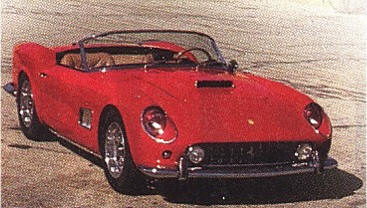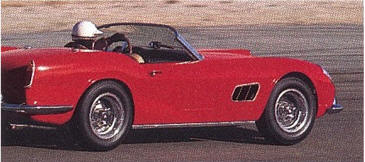 | 330 GT Registry |  |
Respectable
Replicas
Phil Hill helps us examine some great cars at a fraction of the price. But what’s the catch?
BY KIM REYNOLDS
PHOTOS BY JOHN LAMM AND BRIAN BLADES
The quandary: you’ve been a car enthusiast since you could hold a Road & Track magazine. Saved your pennies since the paper route. Endured 30 long years of commuting in one after another clapped-out. 200,000-mile wrecks, taking risks on bald tires and cheap gas-—all so that someday you could smash the piggy and buy that classic sports car of your dreams.
Trouble is, today the great sports cars of your youth have become so astronomically expensive that the closest you can get to them is a chain-link fence at the Monterey Historic Automobile Races. A working life more or less wasted, you figure.
Well, maybe not.
Not if you can become comfortable enunciating one incendiary word: replica. ‘Replica!” the purists among you snort. ‘No phony-baloney cars in my garage!”
Dear reader, you’ve had a traumatic encounter with a Testarossa-bodied Fiero again, haven’t you?
Try to ignore your preconceptions for a moment; there’s an entirely different world of replicas out there that you might not know much about. An island of craftsman-built cars that respectfully honor the originals, offer driving thrills legislated off the road decades ago, and have looks that (in my humble opinion) bring modern machinery to their clay- model knees.
Do you have a reproduction of a Monet on the wall at home? I do. unashamedly. Then let me tell you about a few automotive Monets that might equally adorn your garage.
FINE SPORTS CARS |
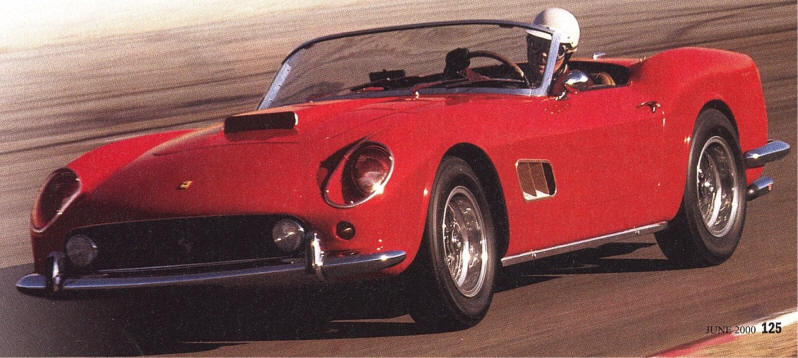
|
Although not long- and short wheelbase California Spyder are actually hard to distinguish from other Ferrari convertibles at the late 1950s and early 1960s, they stand in relief, in small part, because of their name; California Spyder. Few word pairings develop sash a vivid mental photograph. an open-top Ferrari 2-seater, the hair-bleaching California sun your neck, blurred palm trees spitting past the Beach Boys harmonizing from the radio's speakers ("Wouldn't it be nice..."). Sublime stuff. But exactly how did a sports car from Italy’s industrial interior acquire the Golden State’s name?
Nobody really knows, but lore has it (lore, mind you) that California Richie Ginther (at the time driving for Ferrari) suggested to California Ferrari dealer John von Neumann that it was high time for Maranello to replace its defunct 166 Berlinetta. That is, again offer an open-top road car that could be readily converted to racing duty. The idea was passed along so U.S. Ferrari Importer Luigi Chinetti, who passed it along to Ferrari. I pass the story along to you because if nothing else It’s a good one.
In total, approximately 125 Californias were made, 50 of the long-wheelbase cars between 1950 and 1960, 75 of the short-wheelbase cars between 1960 and 1963. All were powered by variants of the fabulous Colombo 3- liter V-12, initially putting out 260 bhp, later 280 bhp. Owning one today will set you back about $1.2 million. That’s roughly $4205 per horsepower.
Ashton Marshall figures he can entangle you is a California spyder’s web for whole lot less than that. Marshall is a buoyant, colorful Aussie; camera-perfect to do TV vacation ads for shrimp on-the-barbie Down Under. Except that Ash has bigger crustaceans to fry, making magnificent reproductions of the world’s greatest sports cars. And his company, Fine Sports Cars, has reproduced almost all of them - D Type jags, Acton Martin DBR2s, Maserati 450Ss, Testa Rossas, even the mid-engine Jag XJR-13, a project the Ford Motor Company lent a hand to. However, the reception he receives from the company whose car he is copying isn't always a bear hug: whereas Aston Martin rolled out the red carpet for the DBR2 project, handing over copies of blueprints, paint and fabric samples, Ferrari doesn’t return his phone calls.
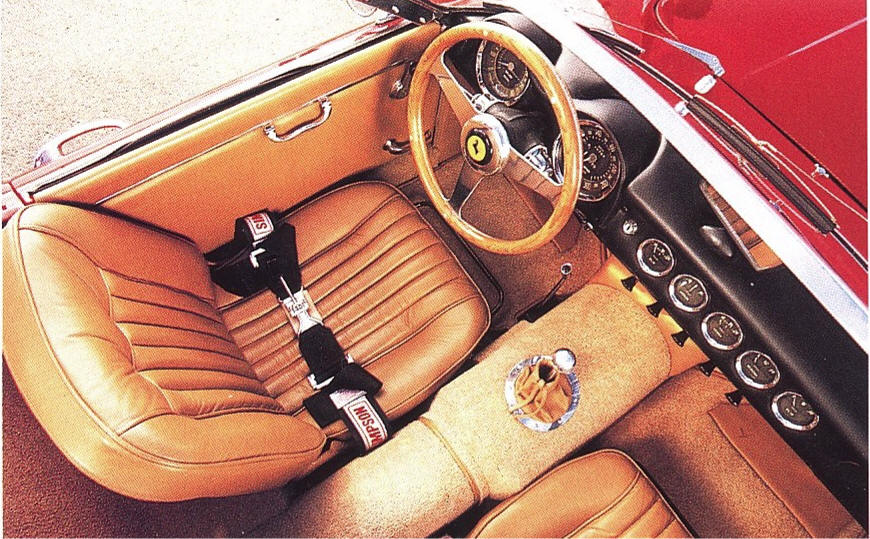
With leather interior, aluminum bodywork and all-Maranello componentry,
the Fine Sports Cars' California Spyder is a convincing reproduction.
No worries, mate. To re-create hit short-wheelbase California Spyder, Marshall’s New Zealand crew locates an uncrashed Ferrari 330 donor car, clips the wheelbase, rebuilds the newer 4.0-liter V-12, hammers out an aluminum body, molds the windshield, fits Borrani wire-spoke wheels and his sticky web is woven. The result is pure Maranello componentry, and the body is frankly identical to what you’d have if your real Spyder were balled up and rebuilt. Perhaps it’s not a perfect reproduction, but within 99 percent of it at 16 percent oft he price.
Phil: “Of course, it feels like a Ferrari because it is a Ferrari. I didn't push it because the engine's fresh, but it has a nice balance, and behaves just like you’d expect. For instance, the brakes are very typically Ferrari — the pedal travel is long, but that’s the way they were. Overall, it’s surprisingly accurate, but then why shouldn’t it be? It’s been fiddled and shortened and such, but it's genuine Ferrari stuff.”
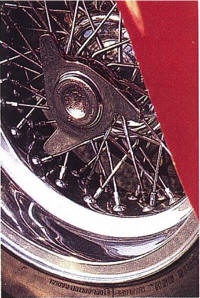 | 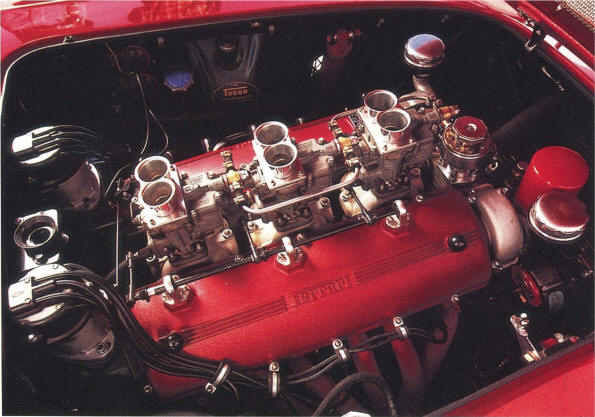 |
| Original California Spyders were powered by a 3.0-liter V-12s; replica uses a new, more powerful 4.0-liter V-12 dressed to look like the original (excepting the red-painted valve covers). |
Conclusions
So should you consider owning a high-quality replica’? The pluses— in saved money and sheer fun—-are obvious.
But under the surface are nagging issues, the most immediate is having to tell every person who asks about it that it’s a replica, a tiresome admission of illegitimacy. Another is that there’s certainly not the investment potential that the real cars possess, with resale values ranging from mildly declining (the Beck Spyder) to gradually appreciating (the California Spyder).
Then there’s the question. “How perfect must a reproduction be?” Would you rather hand-crank the Bugatti to start it—in the name of authenticity? In the middle of a 120-mph racetrack corner, would you really prefer the Lister-Chevrolet’s old De Dion rear suspension to a modern Corvette’s? Finally, I’ve heard the interesting perspective that a reproduction is an indirect theft of the real car’s value, exemplified by the plethora of Cobra replicas that are arguably eating into the actual Cobra’s market values.
On a deeper level, the questions become less subtle. For instance, isn’t part of the fascination of a historic Bugatti the knowledge that this is the very metal and wood that were there, in, say. Williams’ hands at Monaco, a direct witness to history? Similarly, would holding a facsimile of the Declaration of Independence stir you as deeply as feeling the real parchment between your fingers? Of course not.
However, holding (and reading) a copy of it is a lot better than holding nothing at all. Sitting in the Bugatti, after our photo shoot ended, with the warmth of the gearbox against my thigh, the hard wood steering-wheel rim in my palms, was a moment I don’t often experience in modern cars. Reproduction or no, there was something alive here; something down deep. A distant heartbeat of great automotive design And an experience few of us could ever, otherwise, afford to know.
What do the car clubs and vintage racers think?
Say you’ve laid out a hundred thousand dollars on a smart-looking, masterfully made replica and now decide it would be fun to share your enthusiasm with like-minded pals—who own the real cars. How will you be treated by the marque clubs and vintage racing organizations? It depends.
Peter Lech, president of our local Porsche club (Orange Coast 8), reflected that while owning a Beck Spyder would not permit club membership, a Beck driver would be heartily welcomed to any club event. Andy Rheault, registrar and editor of the American Bugatti Club’s Pur Sang publication, notes that owning a Bugatti is no longer necessary for club membership. But you must be recommended by a current member plus show genuine interest in things Bugatti—and spending $175000 to own a Type 35B replica certainly shows enthusiasm
What about vintage racing? Notably, the Vintage Sports Car Club of America wouldn't welcome you, as It restricts itself to cars built before 1960; similarly, Steve Earle of the Monterey Historic Automobile Races notes that his event is intended to encourage the restoration and running of historic machinery, not to provide a venue for replicas— though he readily submits that deciphering whether a car contains enough original parts Is an ongoing headache. Basically, your options are down to finding events staged by organizations with liberal entry policies.
All in all, it sounds like an opportunity for an enterprising soul to fill this very need: a venue for the competition of replicas of superior construction. Not only would It protect Irreplaceable hardware, it would likely foster closer racing. And it might lessen the incentive for fraudulent constructors to pass off replicas as originals, a troublingly common occurrence.—Kim Reynolds
Contacts
Beck Development Inc.
8575 Alta Mesa Rd.
Hesperia, Calif. 92345
(760) 949-0227
Fine Sports Cars
PO. Box 13066
La Jolla, Calif. 92039
(858) 625-3838
Prince of Wales, Inc.
23238 Erwin St.
Woodland Hills, Calif. 91367
(818) 887-6557
Pur Sang Establecimiento
Almafuerte 2650-3100
Paraná. E.R. Argentina
fax: 00 54 343 426 0326
email: pursang@arnet.com.ar
ROAD & TRACK June 2000
Copyright 2000, CBS, Inc.
Note, Bugatti Type 35B, Beck 550 Spyder, Beck Knobbly-Chevrolet, Petersen Blower-Bentley sections omitted.

